Crosses in all their diversity (continued)
Pharmacies, fashion stores,
Balconies, lions on the gate
And flocks of jackdaws on crosses.
"Eugene Onegin". A.S. Pushkin
We have already told here about the crosses, since this symbol was used by the knights-crusaders, the story of which is still to come! However, this topic is so deep and diverse that it is simply impossible to tell all about the crosses in one material. It is important to note that the soldiers with the image of the cross on their shields and robes appeared long before the actual crusaders and crusaders were not called at all. After all, the cross is a symbol for people very ancient, and they began to use it in ancient times, when there was no Christianity either. Those most ancient crosses were also all - both straight and widening at the ends, and with curved cross-pieces ... The latter were called suasti - the word “swastika” originated from this word - and they came to us from North India, where the tribes of the ancient Aryans lived long ago. For them, the ancient swastika meant the unity of the heavenly power of fire and wind with the altar - the place where these forces merge with the forces of the earth. That is why the Aryan altars were decorated with swastikas and were considered a holy place protected by this symbol from all evil. Then the Aryans left these lands and went to Europe, but they transferred their culture and even ornaments to many other peoples, and they also began to decorate their armor and weapon an image of a cross with curved or curved ends.
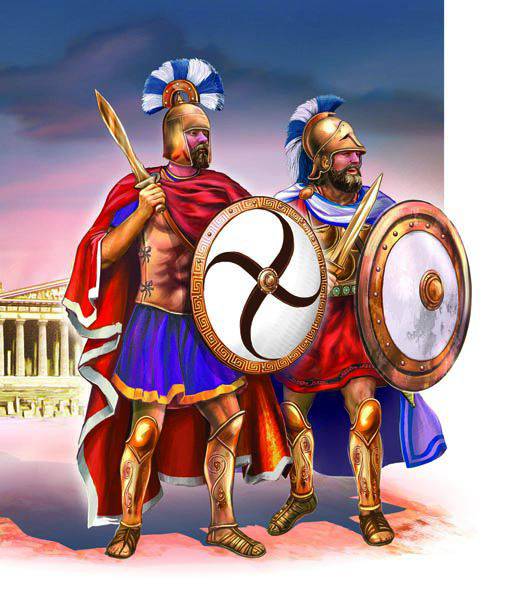
Greek warriors. Reconstruction of the Corinthian vase VII. BC er
This is confirmed by archaeological finds, for example, the image on a Corinthian vase of the 7th century. BC e., found in Etruria. On it one of the soldiers has just such a cross on the shield. By the way, the swastika symbol is on the chest and the largest statue of Buddha Vairochana, completed in 2002 year in the Chinese province of Zhaotsun. Its height is 128 m, and together with the pedestal it is 208 m. To visualize the size of this sculpture, it is enough to compare it with the statue of Christ the Savior in Rio de Janeiro (38 m), the American Statue of Liberty (45 m) and our Volgograd statue “Motherland is calling!” (85 m). So, the image of the swastika (although in European countries it is associated with German fascism in the mass consciousness) is the largest religious symbol in the whole world today! Moreover, this sign was well known in Russia too. The swastika, together with the double-headed eagle, devoid of the attributes of royal power, was depicted on paper notes of the Provisional Government of Russia in 1917 - 1918. The 1000 rubles worth banknote card went into circulation on June 10, and the 250 rubles ticket went on 8 September 1917. In addition, it was used on sleeve insignia and flags of the Southeast Front Red Army soldiers during the Civil War! This emblem was recommended by military expert V.I. in 1918 year. Shorin, a former colonel of the tsarist army and a great connoisseur of the military traditions of the ancient Slavs. Subsequently, namely in 1938, he was repressed and shot as an “enemy of the people” and who knows, maybe this fact of his biography was blamed on him?
Banknote in 1000 rubles 1917
Finally, the swastika disappeared from Soviet symbolism only in 1923, and soon after that Hitler proposed at the congress of the Nazi party a draft red party banner with a black swastika inside the white circle. However, even earlier, during the suppression of revolutionary actions in Germany in 1918, a white swastika with curved ends (that is, as if inscribed in a circle) was worn on his steel helmets by field marshal Ludendorff and ... maybe that's when he saw it for the first time, and Later, having become interested in this sign, I found him a much more “worthy” use. By the way, the Chinese sign of the swastika (Lei-Wen, or “seal of the Buddha’s heart”) was associated with infinity: for them, it meant ten thousand. “Su asti!”, Or “Be Good!” Is the translation of the “swastika” from ancient Sanskrit.
In Russia, the cross with bends even had its own Russian name - Kolovrat. It is interesting that the image of left-handed and right-handed kolovratov and straight crosses adorn the Kiev Cathedral of St. Sofia, built under Yaroslav the Wise, so that the antiquity of this sign on the territory of Russia is beyond doubt.
Our neighbors, for example, Latvians, did not shy away from swastikas. In the Latvian ornament there is, for example, an oblique swastika with rays clockwise. It was called “perconcrusts” - “the cross of Perun”, i.e. symbolized lightning. Moreover, its popularity in this country is evidenced by the fact that since 1919 it was the swastika that became an onboard tactical mark aviation Latvia. The Finns also used it in this capacity, but only blue, and not black, and they had it not oblique, but straight.
By the way, the Christian cross also resembled the ancient Egyptian sign ankh, in which two symbols were united at once: the cross, as a symbol of life, and the circle, as a symbol of infinity. For the Egyptians, it was an emblem of wealth, happiness, eternal life force, eternal wisdom, and even immortality.
At the same time, the image of the cross, which became a symbol of Christianity and the main symbol of this religion, did not become such immediately. In the beginning, the sign of a Christian was the image of a fish. Why fish? Yes, simply because the Greek letters that used to spell this word: iota, hi, theta, upsilon and sigma are the first letters of the words Iesous Christos, Theou Uios, Soter, which means “Jesus Christ, the Son of God, Savior”.
This symbol was used among early Christians in the I-II centuries. AD This symbol was introduced to Europe from Alexandria (Egypt), which at that time was a populous seaport. That is why the ichthys symbol became the first to be used by sailors to designate a god so close to them. But the legionnaires of the Roman emperor Constantine (307 - 337) had on their shields an image of an oblique cross (the Greek letter “xi” or “chi”) combined with the letter “ro” - the first two letters of the name of Christ. This emblem, on his orders, was drawn on the shields after he had a dream that in the upcoming battle he would win precisely by his name! According to Lactantius, a Christian apologist for the 4th century, this happened on the eve of the battle at the Milvia Bridge in 312 AD, after the victory in which Constantine became emperor, well, he himself became the official emblem of the Roman Empire. Archaeologists have found evidence that this sign was depicted on the helmet and on the shield of Constantine, as well as on the shields of his soldiers. On coins and medallions that were circulating under Constantine, they also minted chi ro, and by 350 AD. his images began to appear on Christian sarcophagi and frescoes.
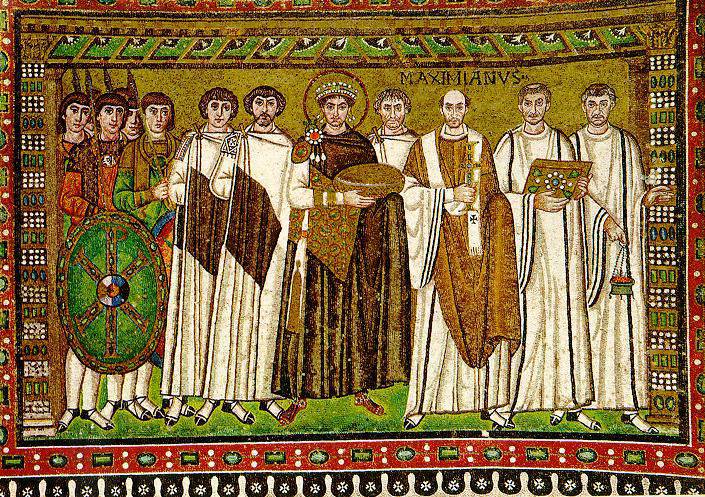
A mosaic depicting Emperor Justinian, to the left of which stands a warrior depicting chi ro on a shield. Basilica of San Vitale in Ravenna.
Vikings - pirates of the northern seas, for several centuries inspired fear in Europe with their devastating raids, at first, being pagans, decorated their shields with various patterns and images. It could be multi-colored stripes, and a chess cage, and terrifying dragons from Scandinavian myths. However, when Christianity began to spread among them, the symbols on their arms changed. Now, more and more often, they began to place on the shields an image of a cross - painted or riveted from metal strips. It even appeared on the sails of their Drakkar, so now, seeing such a ship, it was still possible to find out from a distance whether Christians or pagans are sailing on it, as before worshiping Odin and Torah.
1. Greek cross; 2. The double cross, also called the patriarchal, archbishop's and Hungarian; 3. Lorraine cross - emblem of the duchy of Lorraine, mid-XV century .; 4. The papal cross is not found on the arms of the popes, but received its name by analogy with the patriarchal cross in the 15th century; 5. The Cross of the Kingdom of Jerusalem - The Red Cross of Jerusalem was a symbol of the Order of Sts. Spirit based in 1496 g .; 6. The cross from the coat of arms of the Manfredi family is a rare form of the cross; 7. Cross with ball endings; 8. The scape cross, the crossbars of which end with stylized images of goose paws; 9. Anchor cross; 10. One type of anchor cross; 11. The Maltese Cross - the eight-pointed cross of the Knights Templar; 12. Lily cross with endings in the shape of a lily flower. Belonged to the Spanish knightly Order of Calatrava, founded in 1158; 13. The symbol of the Spanish knightly order of Alcantara; 14. Cross of sv. Jacob - a symbol of the Spanish knightly order of St. James, founded by the king of Aragon Ramiro II; 15. Cross of sv. Anthony. Blue cross on black cloaks worn by members of the Order of St.. Anthony, founded in 1095. Cross of St. Anthony was also one of the emblems of the Knights Templar; 16. Martyr cross of sv. Paul's; 17. Blade Cross; 18. Braided cross; 19. A cross in a nimbus - the Celtic image of a cross, in the Middle Ages was popular in Ireland; 20. The simple black cross of St. Mary of Teutonic - the most famous image of the cross; 21. Faceted cross; 22. A rare cross with bird-headed crosshairs; 23. Nodal cross; 24. Depending on the color, the oblique cross could symbolize different saints: the golden one - the first British martyr of St.. Albana, white or blue - St. Andrew, black - of sv. Osmund, red - of sv. Patrick; 25. Forked cross; 26. Pectoral cross of the most common form; 27. Support, or arc-shaped cross; 28. Shadow (contour) Maltese cross; 29. Christmas cross. This form of the cross was very popular in Finland; 30. Eight-pointed Orthodox, or Russian cross.
As time went on, the cross, as a symbol of the Christian religion, in a sense became very commonplace. For example, on the flags and pennants of the English nobility red straight cross of sv. George was necessarily near the hoist, and only after him was placed one or another image chosen by him as an emblem. The red cross with its widening ends during the war with Napoleon flaunted even on the banner of the Bug Cossacks, who definitely had nothing to do with the crusaders. But on the banner of the warriors of the St. Petersburg militia (as well as many other people's militias of the Russian Empire) in 1812, an Orthodox, eight-pointed cross was depicted, even remotely not similar to Western European crosses.
Flag of Duke Suffolk. Fig. A Shepsa
It would be wrong to say that in the image of the cross in the Middle Ages there was some kind of special tradition. Everyone at that time painted the cross in different ways; Well, there was simply no single cross image for all. Thus, the standard of the Norman Duke Wilhelm (or, as he was called in French, Guillaume) was decorated with a gold cross with T-shaped ends, and almost the same cross later appeared on the banner of the Jerusalem kingdom in the 13th century. flag of Georgia. But on the flag of the Teutonic Order adorned not only the golden Jerusalem cross with a black stroke, but also the coat of arms of the Holy Roman Empire. The banner of France at the time of Charles VII bore the image of gold lilies and a simple white cross, but for some reason, the personal banner of King Charles VIII had such a cross not at the top, but at the bottom. But the battle flag of France - the famous oriflamma - did not have the image of the cross at all, but was the simplest red cloth with flaming ends. There was no cross on the banner of the heroine of the French people, Joan of Arc - instead of him there was embroidered a blessing Lord and a dove carrying an olive branch in his beak.
By 1066, non-Christian in Europe (except for the Iberian Peninsula, captured by the Moors and the pagan Baltic) is almost gone and the image of the cross has become quite familiar. Therefore, it is not surprising that when the Duke Guillaume in the same year went to conquer England, on the shields of his warriors the image of the cross flaunted in the same way.
Saint Istvan in armor and with a cross on the shield.
We know this for certain and, above all, because the conquest of England was barely accomplished, as a huge embroidered cloth of length 75 m and width 70 cm was made, on which all events connected with the famous Battle of Hastings were depicted with eight woolen threads. It knights from Normandy defeated the army of King Harold, after which Duke Guillaume became king in England. This embroidery, later called the “Bayesian Carpet”, besides ships, buildings, people and animals, depicts 67 shields, which we see from the front, and 66 - from the back. Crosses on them for the most part for some reason are shown with curved, and even wriggling ends. And all they have on 22 shields, both oval-shaped - Breton, and Norman, pointed at the bottom, like an inverted raindrop. There are shields without emblems, while a dragon is painted on others. At Guillaume himself, the cross on the shield has ends in the shape of a shamrock, but this is the only such cross on the whole Bayesh embroidery!
Heraldic banners with crosses of the XVI century.
It is obvious that already at that time the cross on the shield had a certain meaning (although it is not clear why both the English and Normans had crosses with wriggling ends) and was popular in the military environment. However, another thing is known, namely, that many shields of the time still depicted mythical creatures and just patterns. So the image of the cross on the shield, most likely nothing so special at that time was not the crusader warriors who had crosses on their shields, no one called!
For many years, the soldiers of Russia who had the shields of the Norman (or as they are also called - the Norman type) also had images of a cross on them, but, of course, Orthodox. The image of the so-called “flourishing cross” and the piercing crescent lying at its base was very popular. However, it is known, for example, the image of a “winged” clawed bird's paw, that is, a paw with an eagle wing attached to it and without any hint of a cross! Leo, standing on his hind legs, was just as popular a motif on the shields of Russian soldiers, and why it is hardly necessary to explain.
Russian warrior with a winding cross on the shield. Modern reconstruction. Museum Zolotarevskogo settlement. S. Zolotarevka of the Penza Region.
Here we have already noted the fact that the cross is not only a European symbol, because, for example, the ancient ancestor of the “real” Christian cross, ankh, was not of Egyptian origin, but a sign of the swastika from India. The cross was also well known in Japan, where its image was associated not only with the spread of Christianity (there were so many Christians in Japan in the sixteenth and seventeenth centuries that it was even forbidden under the crucifixion!), But also with local symbols. The same swastika symbol in Japan was the emblem of the Tsugaru family, which dominated the far north of Honshu. And the red swastika Tsugaru was depicted on the helmets and chestplates of the ashigaru soldiers (gathered from the peasants), and on the large nobori flags, and exactly the same, but golden - on the sashimono - dorsal flags replacing drawings on European knight shields in Japan!
But the image of a direct cross in a circle in Japan meant ... horse bits, that is, the subject is highly prosaic and utilitarian! This emblem belonged to the Shimazu clan - the rulers of lands in the south of Kyushu - Satsuma, Osumi and Hyugi, and they also placed it on the sashimono flags that developed behind them, and on the large nobori flags, and decorated their armor, clothing and weapon As for Christian symbols, such as crosses, images of St. Iago and communion bowls, they were also known in Japan, where they decorated the flags of Christian rebels in Shimabara province in 1638. However, after the defeat of the uprising, all this symbolism was strictly forbidden! Surprisingly, on one flag, miraculously preserved to the present day and painted by hand, the cup for the participle is depicted, in which the cross of St. Anthony is placed, and it is painted in such a way that it is very similar to the ankh sign! Two angels pray at the bottom of it, and at the top there is a Latin motto, which says something about the sacrament, although it’s more accurate not to make out.
However, the peculiarity of Japanese culture was such that even where the eye of a European could see the cross, the Japanese saw (as, for example, in the case of bits!) Something completely different. For example, if you look at the Niva Nagahide standard, a participant in numerous battles of the end of the 16th century, it clearly shows a red oblique cross with pointed ends on a white field. However, the Japanese saw in this only an image of two crossed red boards!
Moreover, the crosses on the shields were also depicted in Japan, but it was only the easel shields made of planks, with a support behind, in the manner of European mantelets, which the ashigaru warriors used to create rows of field fortifications from them they shoot at the enemy from bows and muskets. On each such shield, the mon - coat of arms of the clan to which this ashigaru belonged was usually depicted, and if it was the Shimazu horse or the nagahide monkey, then yes - you could easily see the "crosses" on them as well as on the banners sashimono and nobori!
And also the monarch suzerain was also depicted on the poppy - the commander’s stakes on the battlefield, which looked like a screen, but only made of cloth. The long Maca cloths surrounded it like walls, so that the commander himself was not visible from the outside and, by the way, the presence of these Macyas did not guarantee that he was there. But after the battle won, the victorious commander, of course, settled there and arranged to see the cut off heads that his warriors brought to him. Of course, these heads should have belonged to far from ordinary soldiers. Those simply piled up for general accounting and all. But for the head of the glorified enemy it was quite possible to count on a reward!
Interestingly, the sign of the cross was known not only in Europe and in Asia, but also on the territory of the American continent, and a number of Mesoamerican Indian tribes, for example, the Yucatan Indians worshiped him long before the birth of Jesus Christ. Accordingly, they often depicted him and even carved from stone, as the Spanish chroniclers reported with undisguised surprise! So, among the gods that were worshiped by the ancient Maya, there is the sun god (Ah Kin or Kinich Ahab - Lord-person or the Sunny Eye), the symbol of which was a four-petalled flower. In Palenque there is the “Temple of the Cross” and even the “Temple of the Deciduous Cross”. Hence, in the V-VIII. a completely different continent - in South America - people also worshiped the cross as a symbol of the sun, when Christianity existed in Europe for a long time!
The northern Indians - Indians of the Great Plains, the cross was associated with four sides of the world, each of which had its own patron spirits and also its own color, and with white and clear why the north was always indicated! A simple X-shaped cross in the representation of the Indians personified the man, his strength and masculinity, and if a small circle was added to this sign at the top, then a woman! A vertical cross symbolized perseverance and was a combination of a sign of the earth (vertical line) and sky (horizontal). Later, while continuing to believe in their Manitou, the Indians very widely used crosses made of silver as breast ornaments. At the same time, their sizes were very large, so that they were clearly visible from afar. The fourfold division, as well as the image of the cross itself, was also applied by the Indians of the prairies to their shields, believing that in this way they strengthened their defensive power and in this superstition they, as you see, were no different from the Europeans!
The Dakota Indian Shield with the image of a pointed cross of the symbol of the four sides of the world (Glenbow Museum, Calgary, Alberta, Canada).
The image of the swastika was also known to the Indians of North America, and in particular to the Hopi Indians. With it they associated the wanderings of the clans, of which their tribe consisted on the lands of the North American and South American continents and believed that the swastika, which rotates counterclockwise, that is, to the left, symbolizes the Earth, and the one that to the right - the Sun.
Among the Navajo Indians, a cross in a sand painting symbolized the world, the four sides of the world and the four elements of the universe. At the same time, the horizontal line meant feminine energy, and the vertical line - masculine. The figures, depicted in conjunction with the cross, personify the human world.
That is, the emblem on the shield, whether it is a cross from a European or a black quadrilateral in an Indian of the Sioux tribe, had as its main goal to show who exactly is in front of you, the enemy! However, the shields of the Indians also made women, and in this case the goal was still the same: to reflect the spiritual essence of the owner of the shield. The shields bearing false information were burned, and their owners were punished, up to expulsion from the tribe! Moreover, among the Sioux Indians there was a special “symbol of knowledge”, again in the form of a shield, with the image of four healing arrows containing the doctrine of people. In their opinion, each history and the situation should be viewed from four sides: from the side of wisdom, innocence, foresight and intuition. These four arrows were connected in his center and, thus forming a cross, thus they said that any thing is revealed from different sides, but ultimately combines all directions of knowledge. So the shield showed people how to find out more about themselves, their brothers, about the Earth, and about the whole Universe!
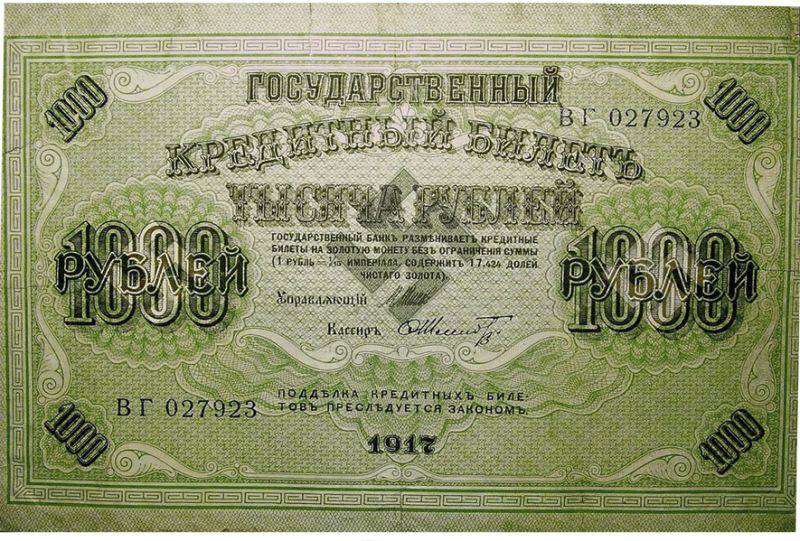
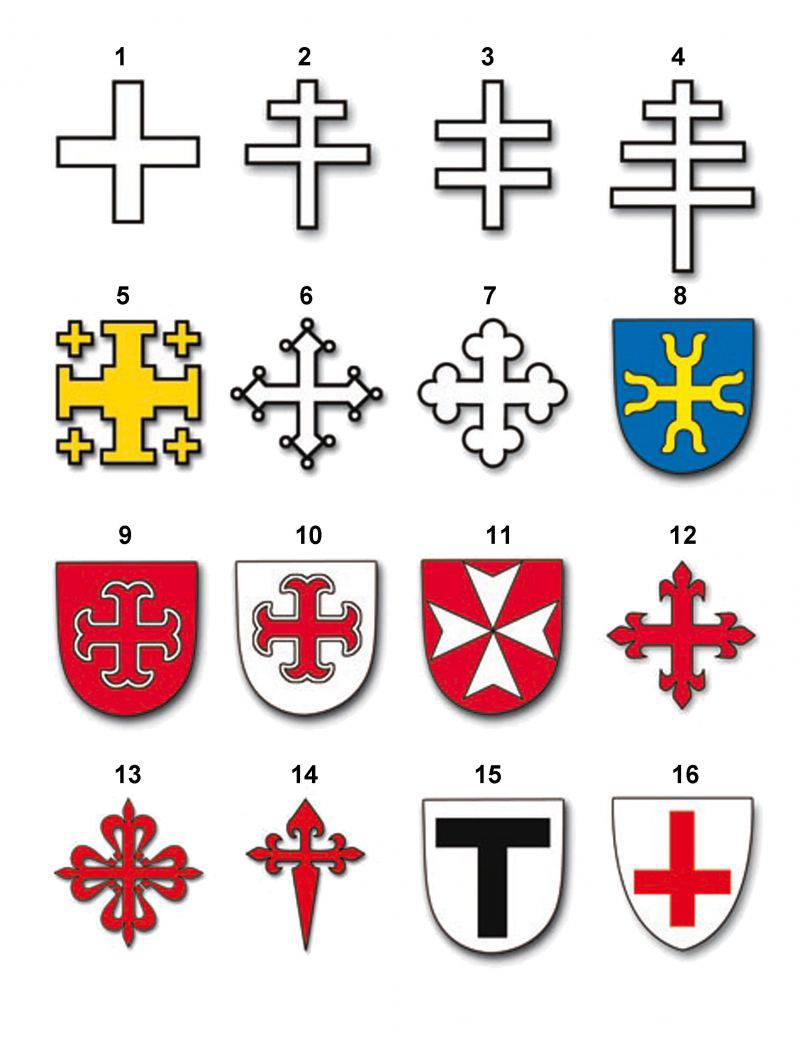
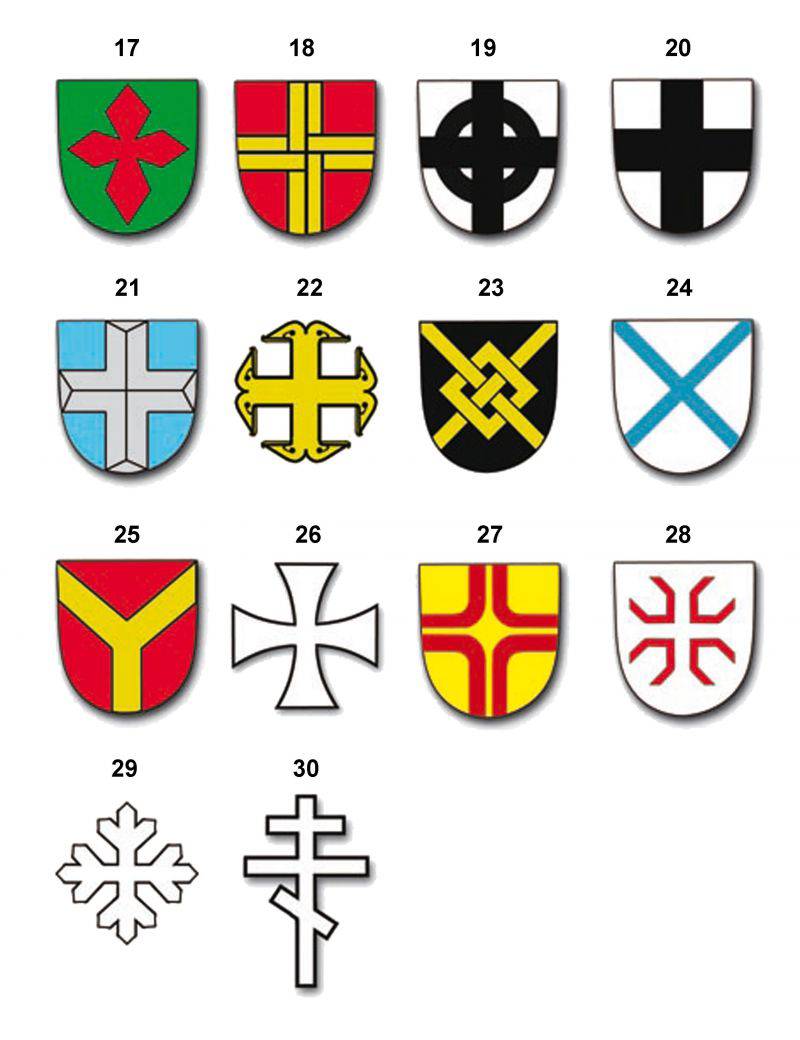

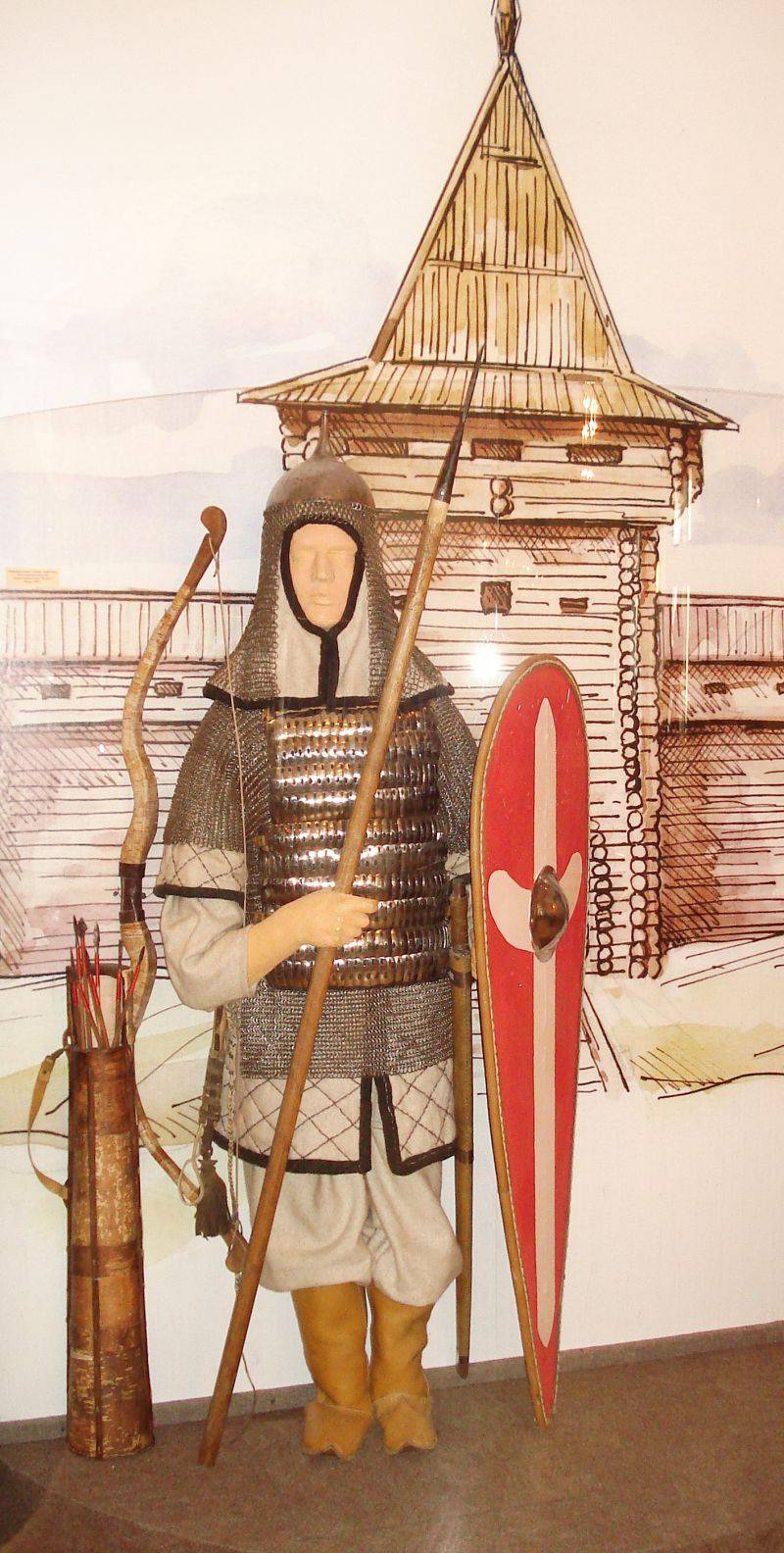
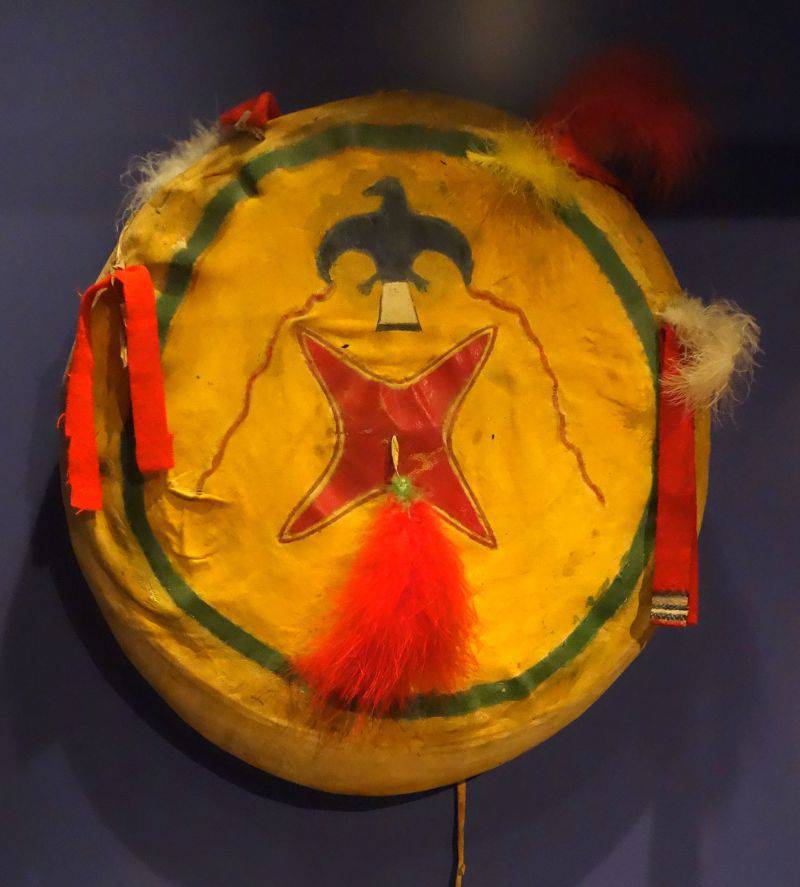
Information